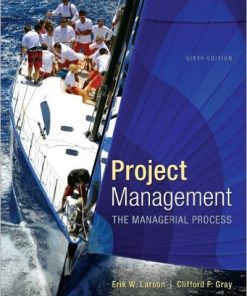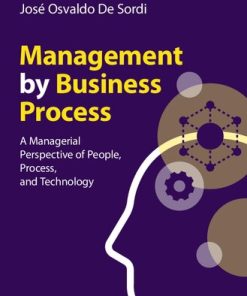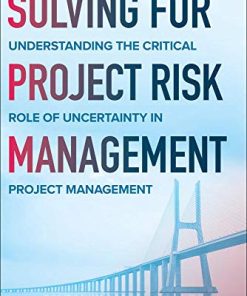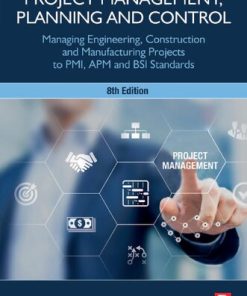(Ebook PDF) Project Management The Managerial Process 8th Edition by Erik Larson 1260736202 9781260736205 full chapters
$50.00 Original price was: $50.00.$25.00Current price is: $25.00.
Project Management: The Managerial Process 8th Edition by Erik W. Larson 1260736202 9781260736205 – Ebook PDF Instant Download/DeliveryISBN: 1260736202, 9781260736205
Full dowload Project Management: The Managerial Process 8th Edition after payment.
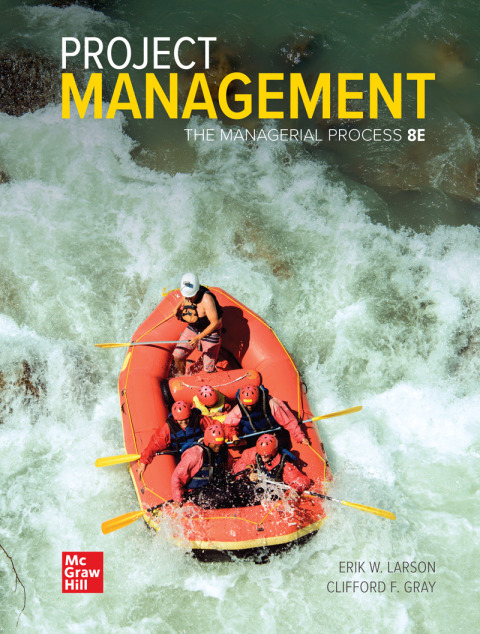
Product details:
ISBN-10 : 1260736202
ISBN-13 : 9781260736205
Author: Erik W. Larson
Project Management, 8e provides a holistic and realistic approach to Project Management that combines the human aspect and culture of an organization with the tools and methods used It covers concepts and skills used to propose, plan secure resources, budget and lead project teams to successful completion of projects. this text is not only on how the management process works, but also, and more importantly, on why it works. It’s not intended to specialize by industry type or project scope, rather it is written for the individual who will be required to manage a variety of projects in a variety of organizational settings. 8e was written for a broad range of audiences including, project managers, students, analysts and Project Management Institute Members preparing for certification exams. The digital component, Connect, now has enhanced algorithmic problems, Application Based Activities, SmartBook 2.0 and Practice Operations, a game-based 3D operations management simulation.
Project Management: The Managerial Process 8th Table of contents:
Chapter 1: Modern Project Management
Introduction
1.1 What Is a Project?
What a Project Is Not
Program versus Project
The Project Life Cycle
The Project Manager
Being Part of a Project Team
1.2 Agile Project Management
1.3 Current Drivers of Project Management
Compression of the Product Life Cycle
Knowledge Explosion
Triple Bottom Line (Planet, People, Profit)
Increased Customer Focus
Small Projects Represent Big Problems
1.4 Project Management Today: A Socio-Technical Approach
Summary
Text Overview
Key Terms
Review Questions
Discussion Questions
Exercises
References
Case 1.1
A Day in the Life—2024
Case 1.2
The Hokies Lunch Group1
Appendix 1.1
2021 PMI: A Guide to the Project Management Body of Knowledge (PMBOK Guide) Seventh Edition and Its Ancillaries
Chapter 2: Organization Strategy and Project Selection
Introduction
2.1 Why Project Managers Need to Understand Strategy
2.2 The Strategic Management Process: An Overview
Four Activities of the Strategic Management Process
2.3 The Need for a Project Priority System
Problem 1: Behavioral Biases
Problem 2: The Implementation Gap
Problem 3: Organization Politics
Problem 4: Resource Conflicts and Multitasking
2.4 Project Classification
2.5 Phase Gate Model
2.6 Selection Criteria
Financial Criteria
Nonfinancial Criteria
Two Multi-Criteria Selection Models
2.7 Applying a Selection Model
Project Classification
Sources and Solicitation of Project Proposals
Ranking Proposals and Selection of Projects
2.8 Managing the Portfolio System
Senior Management Input
Governance Team Responsibilities
Balancing the Portfolio for Risks and Types of Projects
Summary
Key Terms
Review Questions
Discussion Questions
Exercises
References
Case 2.1
Hector Gaming Company
Case 2.2
Film Prioritization
Case 2.3
Fund Raising Project Selection
Chapter 3: Organization: Structure and Culture
Introduction
3.1 Project Management Structures
Organizing Projects within the Functional Organization
Organizing Projects as Dedicated Teams
Organizing Projects within a Matrix Arrangement
Different Matrix Forms
3.2 Project Management Office (PMO)
3.3 What Is the Right Project Management Structure?
Organization Considerations
Project Considerations
3.4 Organizational Culture
What Is Organizational Culture?
Identifying Cultural Characteristics
3.5 Implications of Organizational Culture for Organizing Projects
Summary
Key Terms
Review Questions
Discussion Questions
Exercises
References
Case 3.1
Moss and McAdams Accounting Firm
Case 3.2
Horizon Consulting
Chapter 4: Defining the Project
Introduction
4.1 Step 1: Defining the Project Scope
Employing a Project Scope Checklist
4.2 Step 2: Establishing Project Priorities
4.3 Step 3: Creating the Work Breakdown Structure
Major Groupings in a WBS
How a WBS Helps the Project Manager
A Simple WBS Development
4.4 Step 4: Integrating the WBS with the Organization
4.5 Step 5: Coding the WBS for the Information System
4.6 Process Breakdown Structure
4.7 Responsibility Matrices
4.8 Project Communication Plan
Summary
Key Terms
Review Questions
Discussion Questions
Exercises
References
Case 4.1
Celebration of Colors 5K
Case 4.2
The Home Improvement Project
Chapter 5: Estimating Project Times and Costs
Introduction
5.1 Factors Influencing the Quality of Estimates
Planning Horizon
Project Complexity
People
Project Structure and Organization
Padding Estimates
Organizational Culture
Other Factors
5.2 Estimating Guidelines for Times, Costs, and Resources
5.3 Top-Down versus Bottom-Up Estimating
5.4 Methods for Estimating Project Times and Costs
Top-Down Approaches for Estimating Project Times and Costs
Bottom-Up Approaches for Estimating Project Times and Costs
A Hybrid: Phase Estimating
5.5 Level of Detail
5.6 Types of Costs
Direct Costs
Direct Project Overhead Costs
General and Administrative (G&A) Overhead Costs
5.7 Refining Estimates
5.8 Creating a Database for Estimating
5.9 Mega Projects: A Special Case
Summary
Key Terms
Review Questions
Discussion Questions
Exercises
References
Case 5.1
Sharp Printing, AG
Case 5.2
Post-Graduation Adventure
Appendix 5.1
Learning Curves for Estimating
Exercise A5.1 Developing
Chapter 6: Developing a Project Schedule
Introduction
6.1 Developing the Project Network
6.2 From Work Package to Network
6.3 Constructing a Project Network
Terminology
Basic Rules to Follow in Developing Project Networks
6.4 Activity-on-Node (AON) Fundamentals
6.5 Network Computation Process
Forward Pass—Earliest Times
Backward Pass—Latest Times
Determining Slack (or Float)
6.6 Using the Forward and Backward Pass Information
6.7 Level of Detail for Activities
6.8 Practical Considerations
Network Logic Errors
Activity Numbering
Use of Computers to Develop Networks
Calendar Dates
Multiple Starts and Multiple Projects
6.9 Extended Network Techniques to Come Closer to Reality
Laddering
Use of Lags to Reduce Schedule Detail and Project Duration
An Example Using Lag Relationships—the Forward and Backward Pass
Hammock Activities
Summary
Key Terms
Review Questions
Discussion Questions
Exercises
Creating a Project Network
Work Breakdown Structure
Drawing AON Networks
AON Network Times
Computer Exercises
Whistler Ski Resort Project
Optical Disk Preinstallation Project
Lag Exercises
CyClon Project
References
Case 6.1
Advantage Energy Technology Data Center Migration*—Part A
Case 6.2
Ventura Baseball Stadium—Part A
Case Appendix
Technical Details for the Ventura Baseball Stadium
Chapter 7: Managing Risk
Introduction
7.1 Risk Management Process
7.2 Step 1: Risk Identification
7.3 Step 2: Risk Assessment
Probability Analysis
7.4 Step 3: Risk Response Development
Mitigating Risk
Avoiding Risk
Transferring Risk
Escalating Risk
Retaining Risk
7.5 Contingency Planning
Technical Risks
Schedule Risks
Cost Risks
Funding Risks
7.6 Opportunity Management
7.7 Contingency Funding and Time Buffers
Contingency Reserves
Management Reserves
Time Buffers
7.8 Step 4: Risk Response Control
7.9 Change Control Management
Summary
Key Terms
Review Questions
Discussion Questions
Exercises
References
Case 7.1
Alaska Fly-Fishing Expedition*
Case 7.2
Silver Fiddle Construction
Case 7.3
Trans LAN Project
Case 7.4
XSU Spring Concert
Case 7.5
Sustaining Project Risk Management during Implementation
Appendix 7.1
PERT and PERT Simulation
Case A7.1
International Capital, Inc.—Part A
Case A7.2
Advantage Energy Technology Data Center Migration—Part B
Chapter 8: Scheduling Resources and Costs
Introduction
8.1 Overview of the Resource Scheduling Problem
8.2 Types of Resource Constraints
8.3 Classification of a Scheduling Problem
8.4 Resource Allocation Methods
Assumptions
Time-Constrained Projects: Smoothing Resource Demand
Resource-Constrained Projects
8.5 Computer Demonstration of Resource-Constrained Scheduling
The Impacts of Resource-Constrained Scheduling
8.6 Splitting Activities
8.7 Benefits of Scheduling Resources
8.8 Assigning Project Work
8.9 Multiproject Resource Schedules
8.10 Using the Resource Schedule to Develop a Project Cost Baseline
Why a Time-Phased Budget Baseline Is Needed
Creating a Time-Phased Budget
Summary
Key Terms
Review Questions
Discussion Questions
Exercises
References
Case 8.1
Blue Mountain Cabin
Case 8.2
Power Train, Ltd.
Case 8.3
Tham Luang Cave Rescue
Case 8.4
Midnight Sun II Project
Appendix 8.1
The Critical-Chain Approach
Case A8.1
The CCPM Dilemma
Chapter 9: Reducing Project Duration
Introduction
9.1 Rationale for Reducing Project Duration
9.2 Options for Accelerating Project Completion
Options When Resources Are Not Constrained
Options When Resources Are Constrained
9.3 Project Cost-Duration Graph
Explanation of Project Costs
9.4 Constructing a Project Cost-Duration Graph
Determining the Activities to Shorten
A Simplified Example
9.5 Practical Considerations
Using the Project Cost-Duration Graph
Crash Times
Linearity Assumption
Choice of Activities to Crash Revisited
Time Reduction Decisions and Sensitivity
9.6 What If Cost, Not Time, Is the Issue?
Reduce Project Scope
Have Owner Take on More Responsibility
Outsource Project Activities or Even the Entire Project
Brainstorm Cost Savings Options
Summary
Key Terms
Review Questions
Discussion Questions
Exercises
References
Case 9.1
International Capital, Inc.—Part B
Case 9.2
Ventura Baseball Stadium—Part B
Case 9.3
Whitbread World Sailboat Race
Case 9.4
Nightingale Project—Part A
Case 9.5
Nightingale Project—Part B
Case 9.6
The “Now” Wedding—Part A*
Case 9.7
The “Now” Wedding—Part B
Chapter 10: Being an Effective Project Manager
Introduction
10.1 Managing versus Leading a Project
10.2 Engaging Project Stakeholders
10.3 Influence as Exchange
Task-Related Currencies
Position-Related Currencies
Inspiration-Related Currencies
Relationship-Related Currencies
Personal-Related Currencies
10.4 Social Network Building
Mapping Stakeholder Dependencies
Management by Wandering Around (MBWA)
Managing Upward Relations
Leading by Example
10.5 Ethics and Project Management
10.6 Building Trust: The Key to Exercising Influence
10.7 Qualities of an Effective Project Manager
Summary
Key Terms
Review Questions
Discussion Questions
Exercises
References
Case 10.1
The Blue Sky Project*
Case 10.2
Tom Bray
Case 10.3
Cerberus Corporation*
Chapter 11: Managing Project Teams
Introduction
11.1 The Five-Stage Team Development Model
11.2 Situational Factors Affecting Team Development
11.3 Building High-Performance Project Teams
Recruiting Project Members
Conducting Project Meetings
Establishing Team Norms
Establishing a Team Identity
Creating a Shared Vision
Managing Project Reward Systems
Orchestrating the Decision-Making Process
Managing Conflict within the Project
Rejuvenating the Project Team
11.4 Managing Virtual Project Teams
Mixed Project Teams
Hybrid Project Teams
11.5 Project Team Pitfalls
Groupthink
Bureaucratic Bypass Syndrome
Team Spirit Becomes Team Infatuation
Going Local
Summary
Key Terms
Review Questions
Discussion Questions
Exercises
References
Case 11.1
Kerzner Office Equipment
Case 11.2
Ajax Project
Case 11.3
Franklin Equipment, Ltd.*
Chapter 12: Outsourcing: Managing Interorganizational Relations
Introduction
12.1 Outsourcing Project Work
12.2 Request for Proposal (RFP)
Selection of Contractor from Bid Proposals
12.3 Best Practices in Outsourcing Project Work
Well-Defined Requirements and Procedures
Extensive Training and Team-Building Activities
Well-Established Conflict Management Processes in Place
Frequent Review and Status Updates
Co-location When Needed
Fair and Incentive-Laden Contracts
Long-Term Outsourcing Relationships
12.4 The Art of Negotiating
1. Separate the People from the Problem
2. Focus on Interests, Not Positions
3. Invent Options for Mutual Gain
4. When Possible, Use Objective Criteria
Dealing with Unreasonable People
12.5 A Note on Managing Customer Relations
Summary
Key Terms
Review Questions
Discussion Questions
Exercises
References
Case 12.1
Shell Case Fabricators
Case 12.2
The Accounting Software Installation Project
Case 12.3
Buxton Hall
Case 12.4
Goldrush Electronics Negotiation Exercise
Case 12.5
Umdanso Project
Appendix 12.1
Contract Management
Chapter 13: Progress and Performance Measurement and Evaluation
Introduction
13.1 Structure of a Project Monitoring Information System
What Data Are Collected?
Collecting Data and Analysis
Reports and Reporting
13.2 The Project Control Process
Step 1: Setting a Baseline Plan
Step 2: Measuring Progress and Performance
Step 3: Comparing Plan against Actual
Step 4: Taking Action
13.3 Monitoring Time Performance
Tracking Gantt Chart
Control Chart
Milestone Schedules
13.4 Earned Value Management (EVM)
The Need for Earned Value Management
Percent Complete Rule
What Costs Are Included in Baselines?
Methods of Variance Analysis
13.5 Developing a Status Report: A Hypothetical Example
Assumptions
Baseline Development
Development of the Status Report
13.6 Indexes to Monitor Progress
Performance Indexes
Project Percent Complete Indexes
Software for Project Cost/Schedule Systems
Additional Earned Value Rules
13.7 Forecasting Final Project Cost
13.8 Other Control Issues
Technical Performance Measurement
Scope Creep
Baseline Changes
The Costs and Problems of Data Acquisition
Summary
Key Terms
Review Questions
Discussion Questions
Exercises
References
Case 13.1
Tree Trimming Project
Case 13.2
Ventura Stadium Status Report Case
Case 13.3
Scanner Project
Appendix 13.1
The Application of Additional Earned Value Rules
Chapter 14: Project Closure
Introduction
14.1 Types of Project Closure
14.2 Wrap-up Closure Activities
14.3 Project Audits
The Project Audit Process
Project Retrospectives
14.4 Project Audits: The Big Picture
Level 1: Ad Hoc Project Management
Level 2: Formal Application of Project Management
Level 3: Institutionalization of Project Management
Level 4: Management of Project Management System
Level 5: Optimization of Project Management System
14.5 Post-implementation Evaluation
Team Evaluation
Individual, Team Member, and Project Manager Performance Reviews
Summary
Key Terms
Review Questions
Discussion Questions
Exercises
References
Case 14.1
Halo for Heroes II
Case 14.2
Maximum Megahertz Project
Appendix 14.1
Project Closeout Checklist
Chapter 15: Agile Project Management
Introduction
15.1 Traditional versus Agile Methods
15.2 Agile PM
15.3 Agile PM in Action: Scrum
Roles and Responsibilities
Scrum Meetings
Product and Sprint Backlogs
Sprint and Release Burndown Charts
15.4 Extreme Programming and Kanban
Extreme Programming (XP)
Kanban
15.5 Applying Agile PM to Large Projects
15.6 Limitations and Concerns
15.7 Hybrid Project Management
Summary
Key Terms
Review Questions
Discussion Questions
Exercises
References
Case 15.1
Introducing Scrum at P2P
Case 15.2
Graham Nash
Chapter 16: International Projects
Introduction
16.1 Environmental Factors
Legal/Political Factors
Security
Geography
Economic Factors
Infrastructure
Culture
16.2 Project Site Selection
16.3 Cross-Cultural Considerations: A Closer Look
Adjustments
Working in Mexico
Working in France
Working in Saudi Arabia
Working in China
Working in the United States
Summary Comments about Working in Different Cultures
Culture Shock
16.4 Selection and Training for International Projects
Summary
Key Terms
Review Questions
Discussion Questions
Exercises
References
Case 16.1
AMEX, Hungary
Case 16.2
Phuket A
Case 16.3
People also search for Project Management: The Managerial Process 8th:
project management skills
project management ai
project management articles
project management approaches
project management apps
You may also like…
Business & Economics - Management & Leadership
Business & Economics - Management & Leadership
Business & Economics - Management & Leadership
Mathematics Mathematics - Algebra
Elementary Linear Algebra 8th Edition by Ron Larson 9798214342214
Uncategorized
Mathematics - Mathematical Statistics
Elementary Statistics: Picturing the World, 8e 8th Edition Ron Larson
Business & Economics - Project Management
Business & Economics - Management & Leadership
(Ebook PDF) Contemporary Project Management 4th Edition by Kloppenborg 9798214340753 full chapters




